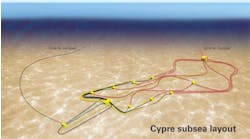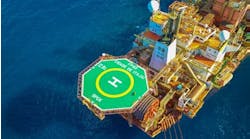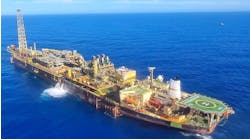Niel PotterNorsk Hydro has a fairly relaxed approach to the Troll C development following the approval of the project by Norway's parliament (Storting) this past June. This followed a period of tension and doubt over environmental issues, specifically involving carbon dioxide emissions from the exhausts of the platform's gas-driven turbines.
Contributing Editor
The production development plan (PDO) for the NKr 15.9 billion project was submitted to the then-Ministry of Industry and Energy in November of 1996. This included a new Troll C floating production platform, modifications to the existing Troll B platform, and 50 new horizontally drilled production wells - 18 linked to Troll B and the remaining 32 tied back to Troll C. Production, at 120,000 b/d, was scheduled to start in September 1999.
So confident of acceptance was Hydro that a letter of intent was issued to Norwegian farbricator Umoe in December for the provision of a steel semisubmersible floater, subject to the PDO being approved. Umoe was to subcontract Hyundai in South Korea to build the hull, while it would fabricate the topsides.
Hydro wanted a subsea separation and water injection system to limit water handling facilities on the floater, and to reduce produced water discharge into the sea. The firm determined that no decision would be made until the carbon dioxide re-injection issue had been resolved.
Some five months later, the energy and environment committee of the Storting discussed the issue of the emissions from Troll C. Some members, as well as environmental lobby groups, were pressing the government to insist that Hydro introduce carbon dioxide re-injection from the start of production.
Costly additions
Hydro argued that injection of all the exhaust from the platform's gas-driven turbines was not feasible. The technology was not fully developed and the equipment could weigh up to 5,000 tons, which would mean a bigger platform, add at least NKr 1 billion to the project's costs, and delay first oil by 12 months.Total power requirements for Troll C are put at 55 mW. The PDO calls for four turbines - two for each generator and two for gas compression.
In May, the Ministry of Petroleum and Energy sent a White Paper to the Storting recommending that the project go ahead without major changes to Hydro's original concept. The document stated that re-injecting carbon dioxide would have been too expensive and would involve a different development solution that the one proposed.
As a compromise, Hydro proposed to prepare the platform to run at a later date on electricity transmitted from shore. The topsides layout is being redesigned and Hydro says that by moving a few modules around, space can be made available for a possible electricity connection.
Troll A platform already runs on about 3 mW of hydropower received by cable from Kollsnes, north of Bergen. As pressure in the reservoir declines, electricity requirements will increase to about 160 mW.
For this reason, Hydro is also looking at the practicality of combining the electricity requirements of the two platforms, with Troll A possibly supplying Troll C. There is, however, no likelihood of Troll C taking shore-based electricity until at least 3-4 years after oil production has started.
Statoil has suggested using land-based power supplies to reduce emissions of carbon dioxide. Combined requirements of the two platforms correspond to almost two-thirds of output from the Naturkraft gas-fired power station at Kollsnes. Ironically, Naturkraft, in which Statoil has a stake, has signed a contract for the annual delivery of 500 million cu meters of gas with the Troll licensees to start in October 1999.
Two gas-fired stations are planned by Naturkraft, the other being at Karsto. Here again, environmentalists are bitterly opposed to the construction of the station, scheduled to start in December. Claiming that carbon dioxide emissions will be unacceptable, demonstrators plan to continue protests. But Norway's prime minister, Thorbjorn Jagland, has said the stations will be built regardless of any protests.
Moving ahead
At the present, plans are moving ahead to develop Troll C and continue studying the technology:- An award was made in May of a NKr 175 million contract to ABB Offshore Technology to build the system, which will be capable of handling production from up to eight wells.
- Kvaerner Environmental has been studying the problem of carbon dioxide cleaning technology for several years. A two-year small-scale project is due to start at Karsto, in conjunction with Statoil, this month. It is believed that it would be 2002 before the first commercial unit would be operational.
- Earlier this year, Statoil said that modifications to six gas turbines on Gullfaks A had yielded substantial environmental and financial benefits. The platform was saving around NKr 2.5 million per year in reduced carbon dioxide tax and lower consumption of fuel gas. Nkr 250,000 was spent on each turbine to modify its air intake. This step cut the annual carbon tax per unit by NKr 250,000, while the savings in fuel is worth almost as much. Five of the turbines are used in normal operation. Conversion work on the turbines is continuing, with anti-icing system as the next target. While spending NKr 500,000 per unit, calculations show that the modifications could trim annual costs by NKr 300,000-500,000.
- Last year, Statoil invested NKr 61 million to install a carbon dioxide separation and injection plant on Sleipner West. Gas produced contains up to 9.5% carbon dioxide, which must be reduced below 2.5% to meet sales gas specifications. Instead of being discharged to the air, the removed carbon dioxide is injected into the water-filled Utsira reservoir 1,000 meters beneath the seabed on Sleipner East. About one million tons of carbon dioxide will be returned underground every year under full production.
Research continuing as costly issue will not go away
Copyright 1997 Oil & Gas Journal. All Rights Reserved.


